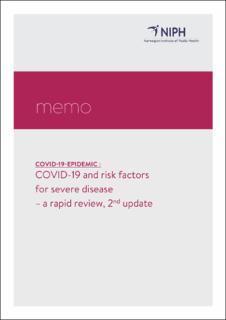| dc.description.abstract | Key message
This rapid review is an update of a version published 14th of April, 2020. In this review update we excluded studies that only reported results from univariate analyses, and studies with small sample sizes (<400 participants).
The findings are based on rapid searches in EndNote database for the Norwegian Institute of Public Health’s systematic and living map on COVID-19 evidence. One researcher screened the search, selected studies for inclusion and synthesised the results. Two other researchers assisted with summarising the results in text, and provided other helpful input during the review process. In the current situation, there is an urgent need for identifying the most important evidence quickly. Hence, we opted for this rapid approach despite an inherent risk of overlooking key evidence or making misguided judgements.
We included 11 studies that reported results from multivariate analyses of age and other demographic risk factors. We excluded risk factors that constituted laboratory findings, vital sign or symptoms of COVID-19. Four studies were from the USA, three from China, two from the UK, one from Iran and one from Brazil. Four of the studies were in press or published in international peer reviewed journals, and seven studies were unpublished pre-prints not subjected to peer review. All but one study were retrospective. The median number of participants in the included studies was 1,580 (range: 442 to 17,425,445).
Meta-analysis was not feasible, and the main results of this rapid review are therefore presented narratively. Risk factors associated with (i) hospitalisation, (ii) severe/critical disease, and (iii) death due to COVID-19 are reported separately below:
Risk factors for hospitalisation due to severe COVID-19
Two unpublished studies reported increased risk of hospitalisation due to COVID-19 with older age, but mixed results for gender and co-morbidity (i.e. hypertension). One of the studies reported significant associations for South-Asian race, high BMI, and many other comorbidities, while the other, smaller study, did not include these outcomes.
Risk factors for developing more severe or critical COVID-19
Results from four studies suggest that age is an important risk factor for developing more severe or critical COVID-19. The results for gender and race/ethnicity were mixed. Most studies provided some support for comorbidity as an important risk factor for severity of disease, but the number and type of comorbidities included in the analyses varied across studies. Two studies identified BMI as an important risk factor for severity of disease, while the other three did not include BMI in their analyses.
Risk factors for death due to COVID-19
Evidence from eight studies suggest that age play a significant role in mortality due to COVID-19. The results for male gender were mixed, but in saying this, it should be noted that two of the largest included studies both reported significant associations between male sex and death. One of these studies also reported significant associations for race/ethnicity in a UK population and deprivation (IMD score), while a smaller study, also from the UK, reported no association for either. Results further indicate that comorbidity may be an important risk factor for COVID-19 mortality, but again the number and type of co-morbidities included in the analyses varied across studies. The evidence for smoking as a risk factor was inclusive.
Conclusion
In conclusion, age stands out as the predominant individual risk factor for hospitalisation, severe disease, and death due to COVID-19. Obesity (BMI>30), male gender and comorbidities are also factors that appear to be associated with increased risk. Race/ethnicity and deprivation may contribute additional risk, but results from different studies point in different directions. Results for smoking habits and use of ACE inhibitors and ARBs are also inconclusive regarding their importance for serious progress and death due to COVID-19.
We did not perform a formal quality assessment of included studies, nor did we grade the certainty of evidence, why the results from this rapid review should be interpreted with caution. In addition, it should be noted that only associations are reported in the included studies, why cause and effect relationships cannot be confirmed or refuted. | |
